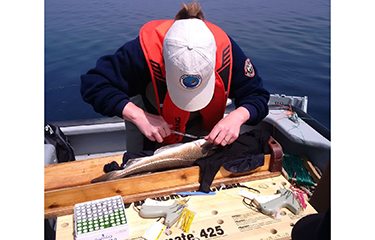Two years into a USD 8.5 million (EUR 7.7 million) cod-tracking initiative, companies are beginning to gather data that could inform scientists’ understanding of Atlantic cod off the coast of Canada and help the fishery recover.
Preliminary data has begun to migration patterns for the fish, with some cod having wide migration patterns and others showing much more narrow movement. There is also early data suggesting that migratory and spawning differences could be driven by two supergenes discovered in the stock.
Launched in 2015 by the Atlantic Groundfish Council (AGC) and the Association of Seafood Producers (ASP), among others, the ASP-AGC Fisheries Improvement Project (FIP) is an ongoing effort to help restore the northern cod stock located off the coast of Canada in the northwest Atlantic Ocean.
In 2019, the ASP-AGC FIP launched a USD 8.5 million (EUR 7.7 million) initiative to tag and track cod in the area, gathering data on migration, spawning, productivity, and more to help restore the commercial fishery.
“The information obtained over the life of this project will eventually enable more effective stock assessment modeling and targeted management measures to control fishing mortality” Bruce Chapman, president of the Atlantic Groundfish Council and FIP co-chair, said in a statement.
The group first began tagging cod in 2019, and deployed an array of acoustic receivers in waters up to 200 miles off Eastern Canada in 2020. The array uploads the data it gathers annually to autonomous ocean gliders.
The group has now collected about two years of telemetry data and hopes to continue collecting data for another three-plus years. The transmitters have a battery life of approximately six-years.
“The intention is to collect data at least for the lifespan of the transmitter batteries but this is dependent on a lot of operational variable(s),” AGC Director of Sustainability Steve Devitt told SeafoodSource.
To date, ASP-AGC FIP has placed transmitters on approximately 800 cod, and about half of those fish have been detected by the NCAT acoustic array at least once.
Simultaneously, the group is mapping the gene of the cod, with early results showing no significant loss of genetic diversity since the collapse of the stock in the 1990s.
“From the 30,000-foot level, the genomic analysis results will provide insights into the genetic variation of the stock following the collapse in the 1990s and information about genome regions potentially associated with local adaptations (e.g. migratory behaviour and spawning timing),” Devitt said. “With a better understanding of the genomic differences throughout the population, this information could be used to inform scientists and managers of potential risk factors associated with particular harvest strategies.”
Stakeholders will meet later this month to discuss when full results will be available and what analyses it plans to do with the data it’s collected, Devitt said.
Photo courtesy of the Atlantic Groundfish Council






